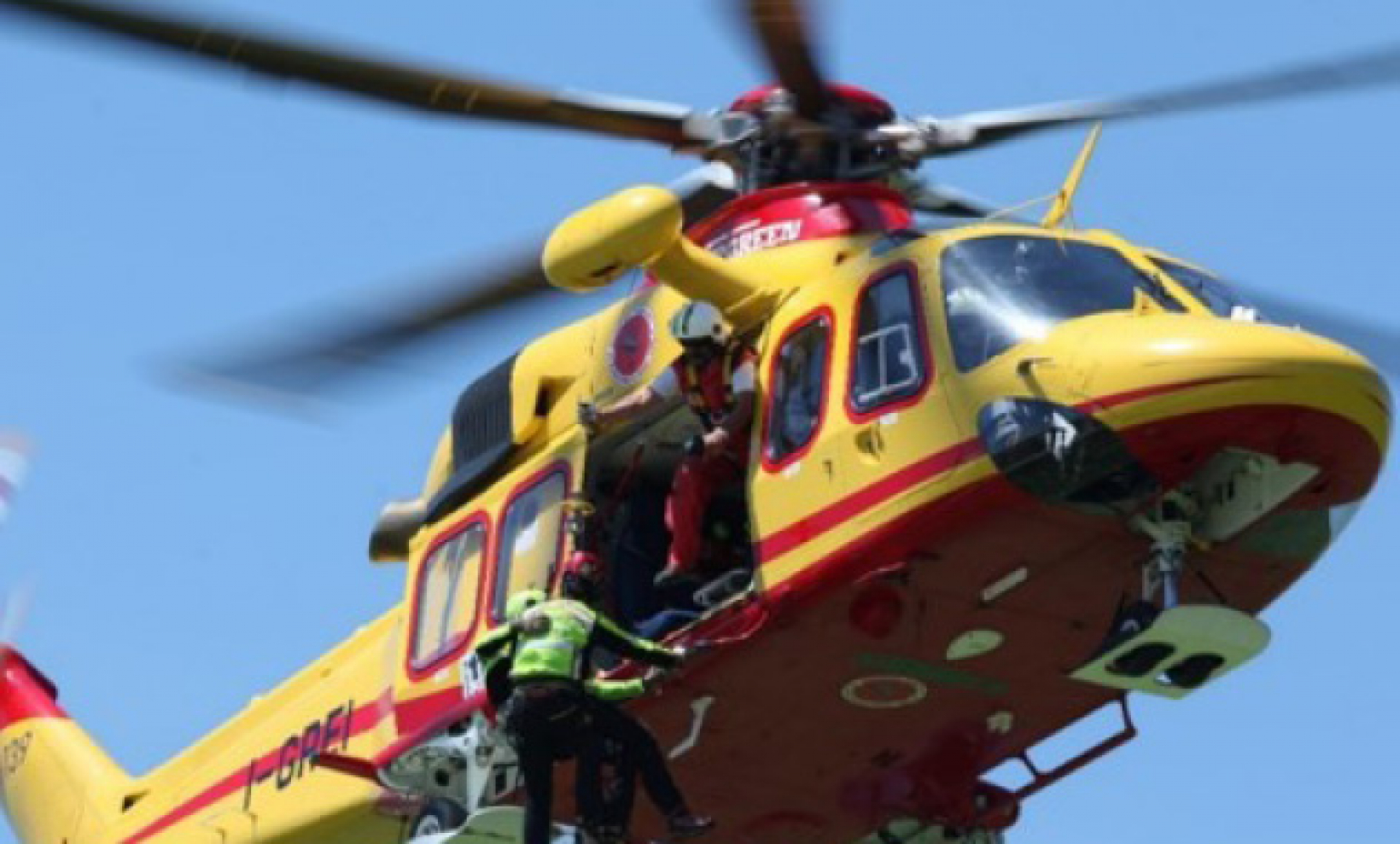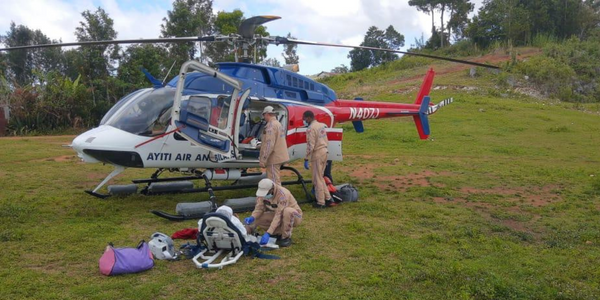Today we are going to talk about a fascinating topic: the role of air ambulances in natural disaster response. Natural disasters can strike unexpectedly, leaving communities devastated and in urgent need of medical assistance. Air ambulances play a crucial role in these situations, as they have the ability to swiftly transport medical personnel and supplies to affected areas that are often inaccessible by land. In this article, we will explore a few case studies that highlight the invaluable contributions of air ambulances during natural disasters. From hurricanes to earthquakes, these case studies will provide us with a deeper understanding of the challenges faced and the impact air ambulances have in saving lives during such catastrophes. So, let’s get started and delve into the world of air ambulances in natural disaster response, shall we?
The Importance of Air Ambulances in Natural Disaster Response
Natural disasters have the potential to cause widespread devastation, affecting both urban areas and remote or inaccessible locations. In these challenging situations, air ambulances play a crucial role in providing life-saving assistance and support. They act as a critical lifeline, offering rapid evacuation, on-site medical care, and aiding in search and rescue efforts. In this article, we will explore the significance of air ambulances in natural disaster response and delve into case studies that highlight their impact.
A Critical Lifeline for Remote or Inaccessible Areas
One of the primary advantages of air ambulances in natural disaster response is their ability to reach remote or inaccessible areas. When disasters strike, roads may be blocked, bridges may collapse, and entire communities may become isolated. In such scenarios, air ambulances can quickly transport medical personnel, equipment, and supplies to these remote locations. They can provide crucial medical care to those in need and evacuate individuals to hospitals or treatment centers, where more specialized care is available.
The Role of Air Ambulances in Rapid Evacuation
During natural disasters, time is of the essence, and rapid evacuation can often mean the difference between life and death. Air ambulances excel in situations where ground transportation is impractical or impossible. Helicopters, equipped with medical personnel and necessary equipment, can swiftly evacuate individuals, particularly those with critical injuries or medical conditions, to hospitals or safe areas. This rapid response helps alleviate the burden on local hospitals and ensures that those in need receive timely and appropriate care.
Providing On-site Medical Care
In addition to their role in evacuation, air ambulances also play a vital role in providing on-site medical care. Natural disasters often result in a large number of casualties who may require immediate medical attention. Air ambulances are equipped to deliver advanced medical care on the scene, stabilizing patients and providing them with the necessary treatment before they can be transported to appropriate medical facilities. This early intervention significantly improves the chances of survival and reduces the long-term impact of injuries.
Supporting Search and Rescue Efforts
Natural disasters can lead to situations where individuals are trapped or stranded, making search and rescue operations critical. Air ambulances are invaluable resources in these circumstances, as they can quickly scan vast areas from the air, identifying survivors and pinpointing their locations. Equipped with specialized equipment and trained personnel, air ambulances can assist in the rescue operations, safely extracting individuals and providing immediate medical attention.
Case Study 1: Hurricane Katrina
Overview of the Disaster
Hurricane Katrina, which struck the Gulf Coast of the United States in 2005, was one of the most devastating natural disasters in American history. The massive storm caused severe flooding, destruction, and loss of life in Louisiana, Mississippi, and Alabama.
Challenges Faced
Hurricane Katrina presented numerous challenges for rescue and relief efforts. The flooding left many areas inaccessible by conventional means, rendering ground transportation impossible. Moreover, the widespread destruction and chaos hindered communication and coordination between different response agencies.
Air Ambulance Response and Impact
Air ambulances played a crucial role in the response to Hurricane Katrina. They were instrumental in evacuating individuals from rooftops, flooded neighborhoods, and hospitals running out of resources. Air ambulances transported patients to hospitals outside the affected areas and provided immediate medical care on board.
Lessons Learned
Katrina highlighted the significant impact air ambulances can have in disaster response. However, it also revealed the importance of improved coordination and communication. The disaster prompted the need for increased training and the implementation of standardized protocols to ensure efficient collaboration and maximize the effectiveness of air ambulance operations.
Case Study 2: Earthquake in Haiti
Overview of the Disaster
The earthquake that struck Haiti in 2010 was a catastrophic event, causing widespread devastation and the loss of hundreds of thousands of lives. The quake severely damaged infrastructure, leaving hospitals in ruins and hindering access to medical care.
Challenges Faced
The earthquake presented immense challenges for emergency responders. The destruction of roads and the collapse of buildings made it difficult to reach survivors and provide immediate medical attention. Additionally, the lack of functional medical facilities put a strain on the limited resources available.
Air Ambulance Response and Impact
Air ambulances played a vital role in the response to the earthquake in Haiti. They provided rapid evacuation of critically injured individuals, bypassing the impassable roads and transporting patients to hospitals. In coordination with ground units and international aid organizations, air ambulances facilitated the delivery of medical personnel, supplies, and equipment to areas where they were most needed.
Lessons Learned
The earthquake in Haiti highlighted the importance of establishing effective coordination mechanisms between air ambulances, ground units, and international responders. It emphasized the need for pre-planning and training in disaster response to ensure a seamless integration of different resources.
Case Study 3: Tsunami in Japan
Overview of the Disaster
The Tohoku earthquake and tsunami that struck Japan in 2011 resulted in widespread destruction, loss of life, and a nuclear crisis. The disaster required extensive search and rescue efforts, medical intervention, and evacuation procedures.
Challenges Faced
The tsunami presented significant challenges due to the scale of devastation and the complex nature of the disaster. Response efforts were hindered by damaged infrastructure, including airports and roads, making access to affected areas extremely difficult. The nuclear crisis further complicated the medical response, requiring specialized expertise and precautions.
Air Ambulance Response and Impact
Air ambulances played a crucial role in the response to the tsunami in Japan. They provided emergency medical care, evacuation, and transportation of patients to hospitals and temporary shelters. Air ambulances were particularly essential in reaching isolated coastal areas that were cut off from other forms of transportation.
Lessons Learned
The tsunami in Japan highlighted the need for disaster response plans that address multiple, simultaneous emergencies. It emphasized the importance of collaboration between air ambulances, ground units, and specialized response teams. The disaster underscored the necessity of maintaining and regularly testing communication systems, ensuring the seamless flow of information between different response agencies.
Case Study 4: Wildfires in California
Overview of the Disaster
California has experienced numerous devastating wildfires in recent years, posing significant challenges to emergency response teams. These fires have led to the evacuation of thousands of residents, destruction of property, and extensive environmental damage.
Challenges Faced
Wildfires present unique challenges due to their unpredictability and rapid spread. The rapidly changing fire patterns and hazardous conditions make access to affected areas dangerous for ground units. Additionally, the smoke and ash can impact air quality, further complicating evacuation and medical operations.
Air Ambulance Response and Impact
Air ambulances have played a critical role in supporting wildfire response efforts in California. They have provided rapid evacuations of residents and emergency medical care as the fires spread. The ability to access affected areas from the air has allowed for timely treatment and the transport of patients to appropriate medical facilities.
Lessons Learned
The wildfires in California have highlighted the importance of maintaining a strong fleet of air ambulances in areas prone to wildfires. It has emphasized the need for coordinated efforts between air and ground response teams, ensuring that evacuation orders are efficiently communicated and executed. Additionally, the wildfires have underscored the significance of ongoing training and preparedness to address the unique challenges posed by these types of disasters.
Air Ambulance Logistics in Natural Disasters
Coordinating with Emergency Management Agencies
In natural disasters, coordination with emergency management agencies is vital for effective air ambulance response. Air ambulances must closely communicate and collaborate with agencies responsible for coordinating rescue and relief efforts. This coordination ensures proper allocation of resources, efficient communication, and the seamless integration of air and ground units.
Utilizing Helipads and Landing Zones
Helipads and designated landing zones are essential infrastructure that enables air ambulances to operate efficiently in disaster zones. During natural disasters, establishing and maintaining these zones becomes even more critical as they provide safe areas for the landing and takeoff of helicopters. Clear communication between ground units and air ambulances is necessary to ensure the availability and accessibility of such landing zones.
Navigating Hazards and Obstacles
Natural disasters create numerous hazards and obstacles that air ambulances must navigate during their operations. These hazards include damaged infrastructure, debris, and challenging weather conditions. Air ambulances must have skilled pilots who are trained to navigate these hazards safely and efficiently while maintaining the utmost care for the patients they are transporting.
Optimizing Crew and Equipment Deployment
During natural disasters, maximizing the effectiveness and efficiency of air ambulance operations is crucial. This involves strategically deploying crews and equipment to ensure they reach the most critical areas in a timely manner. Proper resource management, including maintaining adequate supplies and equipment, is essential to support ongoing medical operations and ensure the availability of resources at all times.
Training and Preparedness for Air Ambulance Crews
Disaster Response Training
Air ambulance crews must undergo comprehensive disaster response training to prepare for the unique challenges posed by natural disasters. This training includes simulations and exercises that simulate realistic scenarios, allowing crews to practice their skills in high-stress situations. Disaster response training ensures that crews are prepared to handle the complexities of natural disasters, including the provision of on-site medical care, safe patient transport, and communication under challenging circumstances.
Specialized Equipment and Supplies
Air ambulances must be equipped with specialized equipment and supplies to respond effectively to natural disasters. This includes advanced life support equipment, trauma kits, and specialized equipment for stabilizing and treating patients in challenging environments. Adequate supplies of medications, intravenous fluids, and wound care materials are also necessary to support on-site medical care and patient transport.
Effective Communication and Coordination
Communication and coordination are crucial elements of air ambulance operations during natural disasters. Crews must have reliable communication systems to relay critical information and receive updates on patient conditions and transportation logistics. Establishing clear communication channels between air ambulances, ground units, and emergency management agencies ensures efficient coordination and maximizes the effectiveness of response efforts.
Collaboration with Ground Units
In natural disaster response, collaboration between air ambulances and ground units is essential for seamless operations. Ground units provide critical support in patient triage, hazardous area assessment, and transportation logistics. By coordinating efforts and sharing information, air ambulances and ground units can work together to provide the best possible care to those affected by the disaster.
Collaboration Between Air Ambulances and Ground Units
Air-Ground Integration Strategies
Effective collaboration and integration between air ambulances and ground units are vital for successful natural disaster response. Establishing clear protocols and strategies for air-ground integration enables seamless coordination, ensuring that patients are quickly transferred from the scene to medical facilities. Regular training and joint exercises between air and ground units improve collaboration and foster effective teamwork.
Timely Transfer of Patients
Air ambulances and ground units must work together to ensure the timely transfer of patients. Ground units play a crucial role in triaging patients, stabilizing them, and preparing them for air transport. Effective communication channels and well-defined transfer protocols ensure that patients are transported smoothly and efficiently, reducing the risk of further complications.
Ensuring Continuity of Care
Collaboration between air ambulances and ground units is essential to ensure the continuity of care during natural disasters. This includes maintaining effective communication on patient conditions, treatment plans, and medical histories. By sharing information and coordinating efforts, air and ground units can provide consistent and comprehensive care to patients from the scene of the disaster to the hospital or treatment facility.
Joint Training and Exercises
Regular joint training and exercises between air ambulances and ground units are critical for fostering effective collaboration and synchronization. These training sessions provide opportunities for teams to practice coordinating patient transfers, communication protocols, and response workflows. By working together in simulated disaster scenarios, air and ground units can identify potential areas for improvement and refine their response strategies.
Challenges Faced by Air Ambulances in Natural Disaster Response
Limited Availability of Helicopters and Resources
Natural disasters often lead to an increased demand for air ambulance services, stretching available resources to their limits. The limited availability of helicopters and trained personnel can pose challenges in efficiently responding to all the calls for assistance. Coordinating the allocation of resources and ensuring adequate coverage becomes crucial to mitigating these challenges.
Adverse Weather Conditions
Natural disasters are often accompanied by adverse weather conditions, such as strong winds, heavy rain, or fog, which can impact air ambulance operations. These conditions may restrict flights, reduce visibility, and make landing or takeoff unsafe. Air ambulance crews must be trained to assess weather conditions, make informed decisions regarding flight safety, and adapt their response strategies accordingly.
Navigating Operational Restrictions
Natural disasters can result in operational restrictions, such as airspace closures, restricted flight paths, or prioritization of other emergency services. Air ambulance crews must navigate these operational challenges while ensuring they can reach affected areas and provide the necessary medical care. Close coordination with local authorities and emergency management agencies is essential to overcome these restrictions and ensure the seamless operation of air ambulance services.
Fatigue and Stress Management
Air ambulance crews responding to natural disasters often endure long working hours and high-stress situations. Fatigue management becomes crucial to prevent crew exhaustion, as well as to maintain situational awareness and the ability to make critical decisions. Effective crew rotation schedules, rest breaks, and mental health support are essential to combating the physical and psychological challenges faced by air ambulance crews in natural disaster response.
Promising Technological Innovations in Air Ambulance Response
Drone Integration for Rapid Assessment
The integration of drones in the air ambulance response to natural disasters shows great promise. Drones can be deployed to rapidly assess disaster-stricken areas, survey damage, and identify critical needs. Equipped with cameras and sensors, drones can provide real-time imagery, helping emergency management agencies and air ambulances allocate resources effectively.
Telemedicine and Remote Consultations
Advancements in telemedicine technology have opened up new possibilities for air ambulance response in natural disasters. Telemedicine allows medical professionals to remotely consult with on-site teams, providing guidance for patient care and treatment plans. This technology enables real-time communication, facilitates decision-making, and ensures that patients receive timely and appropriate care.
Enhanced Navigation and Communication Systems
Advanced navigation systems and improved communication technologies further enhance the capabilities of air ambulances in disaster response. GPS systems, real-time tracking, and satellite communication allow for efficient coordination and enhanced situational awareness. These technological advancements ensure seamless communication, accurate navigation, and timely responses in challenging environments.
Real-time Data Sharing and Analysis
The ability to share and analyze real-time data is crucial for effective air ambulance response in natural disasters. Integrated systems that collect, analyze, and disseminate information enable precise resource allocation, medical prioritization, and decision-making. Real-time data sharing, including patient information and situational updates, enhances coordination and improves overall response efforts.
In conclusion, air ambulances play a vital role in natural disaster response, serving as a critical lifeline for remote or inaccessible areas. They provide rapid evacuation, on-site medical care, support search and rescue efforts, and ensure the continuity of care. Through case studies, we have seen their impact in disasters like Hurricane Katrina, the earthquake in Haiti, the tsunami in Japan, and wildfires in California. Air ambulance logistics, training, collaboration, and technological innovations further contribute to their effectiveness in disaster response. Despite the challenges they face, air ambulances continue to save lives and provide essential medical support, leaving us with hope for a more resilient future.



